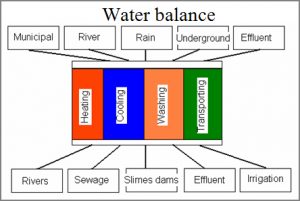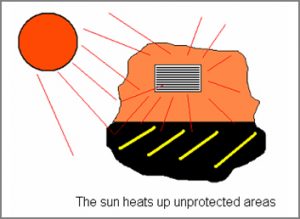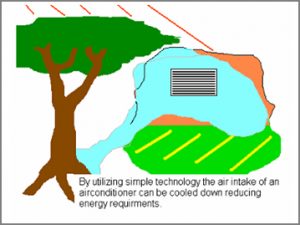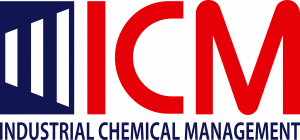our
METHOD
A water balance of the plant is drawn up as to establish the following
• What raw water sources are available?
• What is the quality of the water source and what are the various process requirements.
• Evaluation of effluent and effluent treatment processes.
Step 1.

A water balance of the plant is drawn up as to establish the following
• What raw water sources are available?
• What is the quality of the water source and what are the various process requirements.
• Evaluation of effluent and effluent treatment processes.
Evaluation of each section as to the quality requirements compared to available water sources
• Comparing available water quality as to process requirements.
• Evaluation of the water utilization processes.
• Finding of ways and means for improvement.
Step 2.
A simple example of this is at the inlet of an air-conditioning unit.

The sun heats up the air temperature that is taken into the air conditioner unit and this increases the working rate required by the unit and thus increases on the energy requirements, repairs and maintenance of the unit.
Evaluation of each section as to the quality requirements compared to available water sources
• Comparing available water quality as to process requirements.
• Evaluation of the water utilization processes.
• Finding of ways and means for improvement.
Evaluation and seeking of ways and means to reduce the water and energy intake of the various processes
• Implementation of trial conditions.
• On-site monitoring and modifications.
• Analysis and evaluation of implemented changes.
By improving on the efficiency of the air-conditioning we then have the following benefits.
• Reduced energy requirements.
• Reduced water evaporation.
• Decreased maintenance costs.
• Improved environmental conditions.
• Improved working conditions.
• Increased production unit availability.
• Increased plant production capabilities.
• Increased profit generating possibilities.
Step 3.

Evaluation and seeking of ways and means to reduce the water and energy intake of the various processes
• Implementation of trial conditions.
• On-site monitoring and modifications.
• Analysis and evaluation of implemented changes.
By improving on the efficiency of the air-conditioning we then have the following benefits.
• Reduced energy requirements.
• Reduced water evaporation.
• Decreased maintenance costs.
• Improved environmental conditions.
• Improved working conditions.
• Increased production unit availability.
• Increased plant production capabilities.
• Increased profit generating possibilities.
The final step will be an evaluation and comparison of the conditions before and after the implementation of any changes.
• Permanent installation.
• Training and after sales service.
• Monitoring and control.
Step 4.
The final step will be an evaluation and comparison of the conditions before and after the implementation of any changes.
• Permanent installation.
• Training and after sales service.
• Monitoring and control.
